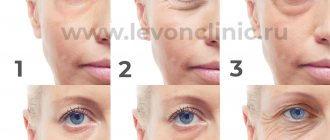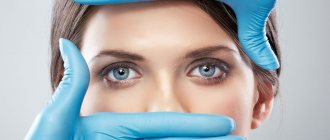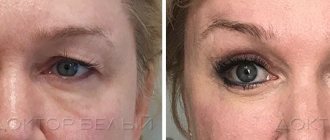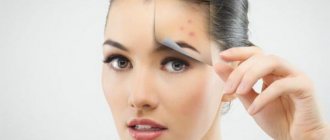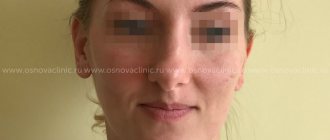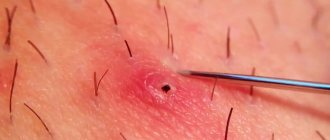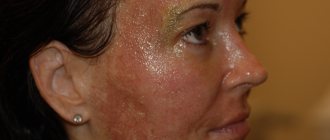Each of us has to deal with swelling of the eyelids from time to time. This could be the consequences of a hard week of work, stress and disappointment, or, conversely, a fun party that lasted until the morning and involved drinking alcohol. You can relieve eyelid swelling at home using simple improvised means. If the cause of the swelling is some disease, a malfunction of the internal organs, then it is better not to experiment, but to consult a doctor and use professional remedies.
How long does swelling last?
One of the most popular questions from patients both before and after surgery is “how long does swelling last after blepharoplasty?” The average recovery time takes about one to two weeks. The duration of rehabilitation depends on factors such as:
- age,
- type of plastic surgery,
- a number of individual characteristics.
It is impossible to name the total number of days it takes for swelling to go away after blepharoplasty outside of a personal case. So, the older the patient, the longer tissue regeneration takes. In addition, older patients often undergo circular surgery, which requires more recovery time. And, naturally, the greater the surgeon’s intervention, the longer the swelling will last. For example, the already mentioned circular plastic surgery with getting rid of bags and tightening the skin will require an increased rehabilitation period.
Reasons for painting bags
To avoid consequences, sometimes it is enough to get rid of the causes. First, let's name these very reasons:
1 Modern gadgets. Especially if we contact in the evening and at night. This affects the muscles of the eyes; the smaller the gadget (phone), the greater the load on the muscles, under the pressure of which they weaken and sag. Therefore, this reason is most often expressed in young people.
2. Heredity. If your parents have it, then you may have it too.
3. Cardiovascular diseases.
4. Problem with the excretory system, leading to edema.
5. Disturbed sleep patterns.
6. Diet (emphasis on salty foods)
7. Use of fillers with hyaluronic acid, if they are introduced superficially.
8. Age-related (tissue ptosis).
For prevention purposes, you need to avoid the causes that provoke this problem. If you have already had injections with hyaluronic acid, after which paint bags appeared, consult a doctor to remove it from the tissues. Go to a therapist, get a cardiogram. Monitor your health, sleep patterns and nutrition.
Recovery time
The first two days after blepharoplasty, swelling remains at its peak stage. There are also noticeable ecchymoses (bruises) on the eyelids, which can even extend to the cheekbones. Four days after the intervention, the swelling subsides slightly and the hematomas become paler. After a week, the severity of the tumor noticeably decreases, but it is still too early to talk about the final result.
The face looks normal already approximately twenty days after the operation, although during this period some fluid may remain in the operated area. After 1-2 months, depending on individual characteristics and following the recommendations, all symptoms indicating a recent operation, including swelling after blepharoplasty of the upper or lower eyelids, completely go away.
After two weeks, the swelling goes away if you do not ignore the care rules.
Blepharitis
Blepharitis is an inflammation of the edge of the eyelid, itching, scales, and bleeding ulcers appear. Reason: infection of the teeth, stomach, liver, disruption of the outflow of tears, etc.
Simple or scaly blepharitis (blepharitis simplex) is characterized by hyperemia of the eyelid margins, the appearance of delicate gray scales and crusts at the base of the eyelashes, loss of eyelashes, and itching. The eyelids are very sensitive to light, dust, smoke; At the same time, they easily turn red and become swollen.
Ulcerative blepharitis (blepharitis ulcerosa) is expressed by moderate swelling of the edge of the eyelids and the formation of purulent crusts at the roots of the eyelashes, under which there are ulcers. Eyelashes stick together in bunches and fall out easily; Some of them, as a result of scarring of the ulcers, take an incorrect position and rub on the eyeball. As a result of the disease, the eyelashes fall out, the edge of the eyelid becomes scarred, thickens, and sometimes an inversion of the eyelid occurs.
Treatment should be aimed at eliminating the cause of the disease: occupational hazards, unsanitary working and living conditions, helminthic infestation. Correction of refractive errors with glasses is also necessary. Taking vitamins internally, especially fish oil and riboflavin, is very beneficial. Tissue therapy may also be recommended. Disinfectants are used locally twice a day - rubbing in ointments (1% yellow mercury, penicillin, synthomycin) or lubricating the edges of the eyelids with a 1% alcohol solution of brilliant green. At the same time, due to concomitant conjunctivitis, a 0.5-1% solution of zinc sulfate or antibiotic solutions is instilled into the conjunctival sac. For ulcerative blepharitis, remove the crusts after softening them with ointment or poultices applied to the edges of the eyelids, and then cauterize the ulcers with greens, iodine tincture or a solution of brilliant green.
How to remove?
The surgeon will tell you how to relieve swelling after blepharoplasty before discharging the patient home. First of all, this is a decrease in physical activity, naturally, refusal from sports, weight lifting and other activities. In the first two days, a cold compress should be applied to the operated area in sessions of 15-20 minutes, three to four times a day, and physiotherapeutic procedures (for example, microcurrents) are also indicated. Hygiene is not prohibited, but in the first days it is undesirable to allow detergents and water to come into contact with the operated area. It is also recommended to limit computer work and the use of contact lenses.
How to remove swelling after blepharoplasty - what other rules exist? For two weeks you should give up cosmetics - both decorative and skincare. After the due date, it is recommended to use hypoallergenic products with gentle composition. To remove swelling as soon as possible, the doctor additionally prescribes special ointments and medications that help resolve lumps and bruises. Remember that self-prescribing medications is highly undesirable!
Folk remedies for eliminating swelling of the eyes
Folk recipes against swelling of the eyelids offer various masks, lotions for local use based on medicinal herbs, vegetables and fruits, or decoctions and infusions of them for internal use.
Cucumber slices, chamomile infusion or tea bags - traditional medicine offers many remedies to combat swelling
You can quickly relieve swelling in the eyes that appears after a feast, for example, with the help of simple parsley. It is useful to use any part of a garden plant - leaves, stems, roots. Greens have a diuretic and anti-inflammatory effect; traditional medicine recommends brewing the roots and seeds of the plant for internal use, and making external masks from a paste of parsley leaves. This is a proven, safe and affordable remedy.
What other available tools can you use:
- Cold. An ice cube, a compress soaked in ice water, or a chilled tablespoon will help remove puffy eyes in the morning.
- Carrot. If you are prone to swelling, it is useful to drink freshly squeezed carrot juice and make masks from the grated root vegetable. But masks will require caution, since carrots have a coloring effect.
- Flax seeds. A spoonful of seeds is steamed in a thermos with a glass of boiling water and left overnight; the resulting decoction is filtered and taken a third of a glass throughout the day, or you can use it as an eye lotion. This is an ancient folk remedy for any swelling and inflammation.
- Tea with peppermint or linden. These drugs also have anti-inflammatory, decongestant and diuretic effects. You can brew calendula, chamomile, sage, fireweed, and thyme.
- Chilled milk. Cotton sponges are soaked in milk and applied to swollen eyes for a quarter of an hour.
- Black or green tea bags. After drinking tea, you should not pour out the tea leaves or throw away the tea bags - this is an excellent, quick and effective remedy against bags under the eyes, swelling, and dark circles.
- Potato. Use gruel from raw grated root vegetables or warm boiled potatoes, which should be peeled and mashed, as eye masks. To enhance the effect, you can add a spoonful of sour cream to the mixture.
- Egg white. Protein has an astringent and smoothing effect, brightens the skin, smoothes it and tightens it. Beat the egg white a little with a fork and apply it under the eyes with a brush. After ten minutes, the mask is carefully washed off with warm water.
Removing swelling from the upper or lower eyelid is not so difficult. It is important to understand that they do not simply arise, and to prevent the recurrence of an unpleasant symptom.
Salty foods, alcohol, cigarettes, coffee and soda - this is what you need to forget about if circles and bags under the eyes bother you
What to do if swelling does not go away after blepharoplasty?
For each patient, the period for how long swelling lasts after blepharoplasty is strictly individual. However, the obviously protracted recovery process requires immediate contact with your surgeon. Also a cause for concern should be severe tissue density, suppuration, increased body temperature, and more.
Swelling, swelling, bruises like after a bruise are normal and are not considered complications (provided they go away in due time). If in any doubt, if eye swelling after blepharoplasty lasts too long, it is better to visit the doctor who performed the operation and get professional advice and, possibly, additional therapy - other drugs or procedures.
Barley
Barley (hordeolum) is a purulent inflammation of the hair follicle or sebaceous gland at the root of the eyelashes.
Barley - appears as a swelling, painful, when the barley is opened, pus is released. Squeezing is strictly prohibited due to possible blood poisoning and inflammation of the meninges.
Ingestion of brewer's yeast is also recommended. The disease begins with limited hyperemia and painful swelling of the skin at the edge of the eyelid. Soon an abscess appears, upon opening of which pus and particles of necrotic tissue are released. Styes often recur and often accompany blepharitis. Dry heat or UHF therapy is applied locally. Due to the danger of the process spreading through the venous system, ointments should not be rubbed in or barley squeezed out. In the intervals between relapses of styes, the same local treatment as for simple blepharitis is useful.
Other recovery tips
To speed up the removal of swelling after blepharoplasty and the passing of bruises, it is advisable to sleep half-sitting and wash your hair with your head thrown back. It is recommended to avoid ultraviolet radiation, alcohol, and cigarettes. You are not allowed to visit the swimming pool, bathhouse or sauna. You will receive more detailed instructions from your surgeon.
It goes without saying that all these prohibitions are temporary, and after the end of the rehabilitation period it will be possible to return to normal life. With proper care and compliance with all recommendations and prohibitions, bruises and swelling after blepharoplasty will go away very soon, and it will be possible to sum up the results based on the existing aesthetic result, which will undoubtedly please the patient.
Ptosis
Drooping of the upper eyelid - ptosis (ptosis) can be congenital or acquired. The latter occurs due to injury to the eyelid and paralysis of the oculomotor nerve. Based on the degree of drooping of the eyelid, partial and complete ptosis are distinguished. With congenital ptosis, patients raise their eyelids, straining the frontalis muscle, as a result of which the skin of the forehead gathers in folds; The patient's head is slightly tilted back. Sometimes patients, especially children, lift their eyelids with their fingers.
Treatment , which can be conservative in cases of acquired ptosis, should be aimed at eliminating the cause of the underlying disease; To clarify this, the patient must be shown to a neurologist. In case of irreversibility of the process, as well as in congenital ptosis, surgery is indicated, the purpose of which is to strengthen the function of the muscle that lifts the upper eyelid.
Gymnastics for eyelids and eyebrows
Make it a point to make several movements with your eyelids and eyebrows while using the toilet (men during shaving, women during cosmetic procedures). In most cases, in people with poor vision, this is accompanied by a feeling of heaviness. Looking in the mirror, begin to lift the upper eyelids, first of both eyes together, and then separately. Continue the exercise, bringing your eyebrows into action.
The following technique will help you practice the absolute independence of the movements of the eyebrows and especially the eyelids of the right and left eyes from each other. It is based on the fact that if you focus your gaze on the reflection in the mirror of one eyelid, then in some way you will not see the eyelid of the other eye. Smoothly raise and lower the eyelids of both eyes until you feel that you have mastered and memorized the action of the muscles, then fix your gaze on one eyelid and order it to move, without stopping the movement of the other eyelid. These exercises are not just grimacing in front of the mirror. They expand and deepen blood circulation, massage the lacrimal glands and their excretory canals, and are therefore extremely useful, especially in the morning, after a period of overnight exposure, which predisposes to the accumulation of thick mucous substances (discharge that sticks together the eyelids, white formations in the corners of the eyes, etc.). d.
